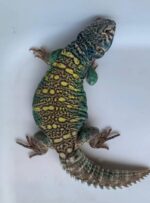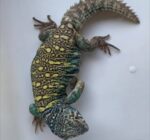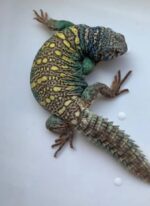Description
Arabian blue uromastyx for sale is a genus of lizards in the family Agamidae. The genus is native to Africa and the Middle East (West Asia). Member species are commonly called spiny-tailed lizards, uromastyces, mastigures, or dabb lizards.
Arabian Blue Uromastyx For Sale in the genus Uromastyx are primarily herbivorous, but occasionally eat insects and other small animals, especially young lizards. They spend most of their waking hours basking in the sun, hiding in underground chambers at night time or when danger appears. They tend to establish themselves in hilly, rocky areas with good shelter and accessible vegetation.
Taxonomy of Arabian Blue Uromastyx For Sale
The generic name Uromastyx is derived from the Ancient Greek words ourá (οὐρά) meaning “tail” and -mastix (μάστιξ) meaning “whip” or “scourge”, after the thick-spiked tail characteristic of all Uromastyx species.
Species of Arabian Blue Uromastyx For Sale
The following species are in the genus Arabian Blue Uromastyx For Sale. Three additional species were formerly placed in this genus, but have been moved to their own genus, Saara.
| Image | Scientific Name | Common Name | Distribution |
|---|---|---|---|
 |
Uromastyx acanthinura Bell, 1825 |
North African mastigure, North African spiny-tailed lizard | Morocco, Algeria, Tunisia, Libya, Egypt, Western Sahara, Chad, Mali, Niger, and Sudan |
 |
Uromastyx aegyptia (Forskål, 1775) |
Egyptian mastigure, Egyptian spiny-tailed lizard | Egypt and the Middle East. |
| Uromastyx alfredschmidti Wilms & Böhme, 2001 |
ebony mastigure, Schmidt’s mastigure, Schmidt’s spiny-tailed lizard | Algeria and Libya.The spiny tail of the Uromastyx serves as a defense mechanism, which the lizard swings at predators to protect itself. The tail’s spines can inflict damage, making it an effective tool for deterring threats | |
 |
Uromastyx benti (J. Anderson, 1894) |
Bent’s mastigure, Yemeni spiny-tailed lizard | Oman and Yemen. |
 |
Uromastyx dispar Heyden, 1827 |
Sudan mastigure | Mauritania, Sudan, Chad, Western Sahara, Algeria, and Mali. |
 |
Uromastyx geyri (L. Müller, 1922) |
Geyr’s dabb lizard, Geyr’s spiny-tailed lizard, Sahara mastigure, Saharan spiny-tailed lizard, Saharan yellow uromastyx, yellow Niger uromastyx | Algeria, Mali, and Niger. |
| Uromastyx macfadyeni H. Parker, 1932 |
Macfadyen’s mastigure | Somalia | |
 |
Uromastyx nigriventris Rothschild & Hartert, 1912 |
Moroccan spiny-tailed lizard | Morocco and Algeria. |
| Uromastyx occidentalis Mateo, Geniez, López-Jurado & Bons, 1999 |
Western Sahara | ||
 |
Uromastyx ocellata Lichtenstein, 1823 |
ocellated spinytail, eyed dabb lizard, ocellated uromastyx | southern Egypt, Sudan, Eritrea, Djibouti, Ethiopia (near the Somali border), and northwestern Somalia |
 |
Uromastyx ornata Heyden, 1827 |
ornate mastigure | Egypt, Israel, Saudi Arabia, and Yemen |
 |
Uromastyx princeps O’Shaughnessy, 1880 |
princely spiny-tailed lizard, princely mastigure, Somalian mastigure | Somalia, Ethiopia |
| Uromastyx shobraki Wilms & Schmitz, 2007 |
Yemen | ||
 |
Uromastyx thomasi H. Parker, 1930 |
Omani spiny-tailed lizard, Thomas’s mastigure | Oman |
| Uromastyx yemenensis Wilms & Schmitz, 2007 |
South Arabian spiny-tailed lizard | Yemen |
Nota bene: A binomial authority in parentheses indicates that the species was originally described in a genus other than Uromastyx.
Description of Arabian Blue Uromastyx For Sale
Uromastyx species range in size from 25 cm (10 in) for U. macfadyeni to 91 cm (36 in) or more for U. aegyptia. Hatchlings or neonates are usually no more than 7–10 cm (3–4 in) in length.[citation needed] Like many reptiles, these lizards’ colors change according to the temperature and season.
During cool weather they appear dull and dark, but the colors become lighter in warm weather, especially when basking. The darker pigmentation allows their skin to absorb sunlight more effectively.























Reviews
There are no reviews yet.